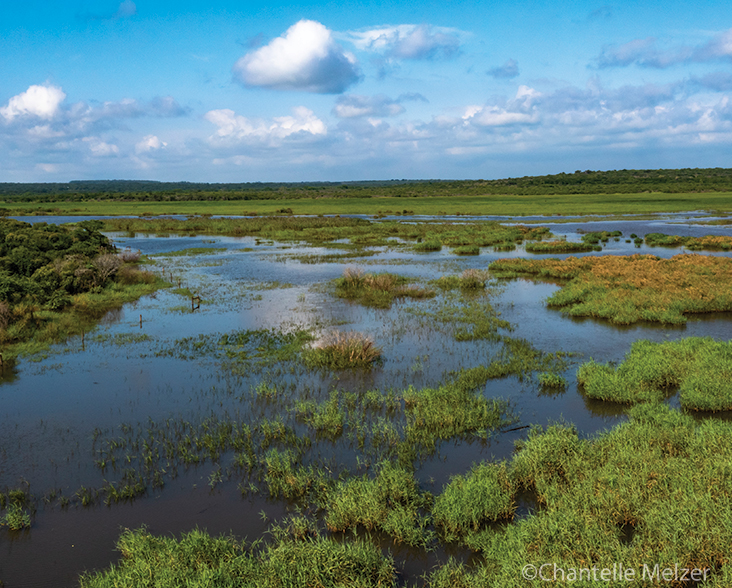Nile Crocodile
Species Data
Class: Reptilia
Order: Crocodylia
Family: Crocodylidae
Scientific Name: Crocodylus niloticus
IUCN Red List status: Least Concern
Description
The world’s second-largest crocodilian and the largest of the three African species, adult male Nile Crocodiles average 5 m long and typically weigh 400-500 kg but can reach a length of 6.1 m and weigh up to 900 kg. Adult females are 20-30% smaller, averaging 3.5 m long and weighing 50-350 kg.
The Nile Crocodile has a pointed snout with a large number of teeth conspicuously protruding from the mouth when closed. Adults are uniform or blotched olive or grey on the dorsal surface with darker crossbands on the tail, and juveniles are olive-brown to green with more noticeable black crossbands on the body and tail. The belly is usually a straw-yellow colour. This species has six nuchal scales including two smaller outer ones, a single row of post-occipitals, and a protuberance behind the eye.
Like all crocodilians, the Nile Crocodile has short legs with clawed webbed toes, a powerful tail, and the jaw ha 64-68 sharp conical teeth, which are replaced around 45 times throughout their lifespan. The green eyes are located on top of the head to protrude above water when surfacing, and their eyesight is excellent, allowing them to see well at night and by day and above and below water simultaneously when submerged.
Behaviour
Being cold-blooded or ectothermic, Nile Crocodiles spend much of the day basking on sandbanks and river banks, raising their core body temperature to 38°C, which they can regulate by opening their mouths. They are primarily nocturnal, active from late afternoon until the first hours after dark when they use the energy absorbed from the sun to hunt, socialise, and digest food until their body temperature drops to around the ambient temperature of their environment or 15°C if lower.
The Nile Crocodile is an opportunistic ambush predator, lying submerged in the water with only its eyes, ears, and nostrils above the surface, motionless or floating like a drifting log waiting for prey to come within striking distance. Nile Crocodiles have a metabolism that allows them to survive for long periods without food. The diet of an adult comprises 70% barbel, with large mammals such as zebra, buffalo, warthog, hyaena, baboon, wildebeest, impala, and even Giraffe and Lion, the unsuspecting animal grabbed at speed by the water’s edge and dragged into the water, held by their powerful jaws until it drowns. Large prey is torn into smaller pieces by jerking the head back and forth or by twisting in a death roll. Along with flesh, powerful enzymes digest bones, hooves and feathers. Carrion is eaten only when fresh food is unavailable.
During the breeding season, which varies from May to August, males become territorial and aggressive towards each other. Males establish small territories, bellowing, slapping their snouts on the water’s surface, or blowing water out of their noses to attract females. Females move between territories to mate with several males. Females excavate a nest hole close to the water’s edge 40-50 cm deep before laying 25-90 eggs and covering them in a layer of sand, often nesting colonially. Both sexes reach sexual maturity at 10-12 years old.


Habitat
The Nile Crocodile is distributed across much of central, eastern, and southern Africa, occurring in inland freshwater wetland habitats such as rivers, lakes, swamps, desert oasis pools, and subterranean streams in caves, as well as in coastal saline habitats like estuaries.
Threats and Conservation
The Nile Crocodile is one of the most commercially exploited crocodilians. Between the 1940s and 1970s, populations declined throughout much of their range due to hunting for skins. In 1973, the Nile crocodile was listed in CITES Appendix I, leading to numbers recovering in parts of its range. However, national populations in Botswana, Ethiopia, Kenya, Madagascar, Namibia, South Africa, Uganda, Tanzania, Zambia and Zimbabwe have been moved to Appendix II, allowing controlled trade in species not threatened with extinction, which has now largely eliminated the illegal international trade in crocodile skins.
The population is currently considered stable at around 50,000-70,000 mature individuals and is listed as Least Concern on the IUCN Red List. However, threats include human-crocodile conflict, especially retaliatory killings in response to human deaths and cattle predation; habitat destruction such as flooding of basking sites by dams and fewer nesting sites as a result of expanding human settlements; pollution of water courses and increased mortality in aquatic food chains caused by mining, industry, agriculture and urbanisation; exploitation of both animals and their eggs for food and traditional medicine; overfishing; and the effect of the invasive Siam Weed on Nile Crocodile reproduction in South Africa.
